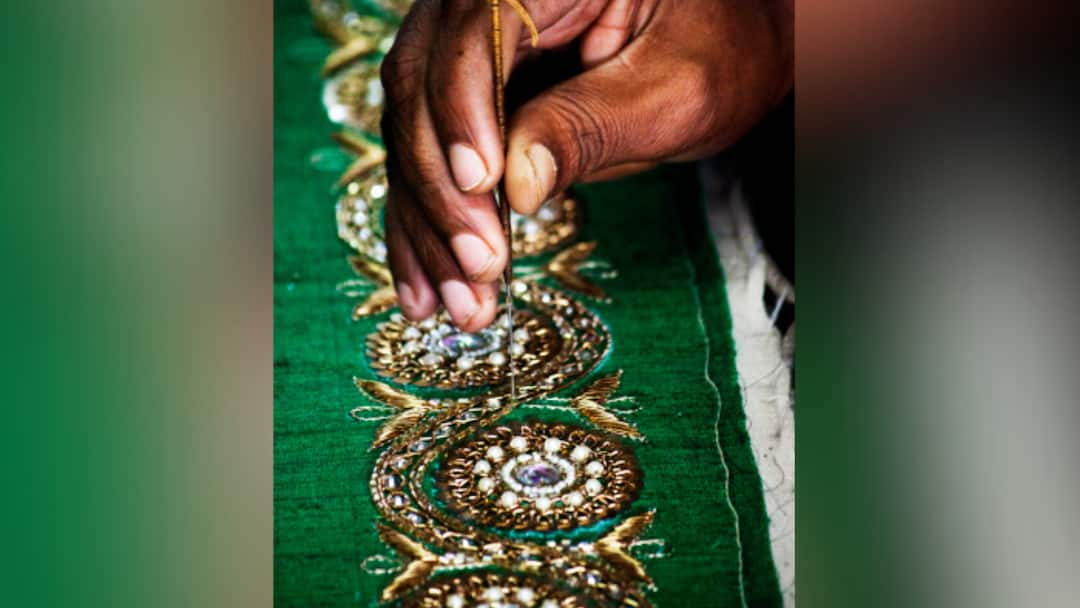What Is Zardozi Embroidery? Know How You Can Identify A Pure One And Things To Keep In Mind Before Buying
Zardozi is a type of heavy and elaborate metal embroidery on a silk, satin, or velvet fabric base that uses a wide variety of gold and silver embellishments.

Zardozi is an Iranian, Indian-subcontinent and Central Asian embroidery that comes from two Persian words: zar or zarin meaning 'gold', and dozi meaning 'sewing'. It is a type of heavy and elaborate metal embroidery on silk, satin, or velvet fabric base that uses a wide variety of gold and silver embellishments such as: flat metal wires, spangles, coiled wires, heavy wires, and twisted wires. Designs are often created using gold and silver threads and can incorporate pearls, beads, and precious stones.
This intricate form of heritage embroidery was introduced to India during the Mughal era and has evolved today as a traditional technique that is practiced by artisans in different parts of India evolving a more contemporary language.
Talking about the evolution of Zardozi in today's time, Pearl Upal, Founder and Creative Director of Talking Threads said, "The technique has evolved to include the use of different materials such as silk, velvet, and cotton, and a wider range of motifs influenced by modern designs."
Zardozi embroidery can elevate various types of outfits, adding a touch of opulence and glamour.
"Outfits that work well with Zardozi embroidery include traditional Indian wear like sarees, lehengas, sherwanis, and kurta sets. The art is perfect for bridal and wedding wear giving an exotic touch to contemporary fusion wear as well. The embroidery can be paired with less dramatic outfits such as dresses, blouses, and skirts to elevate the look," said Pearl.
How You Can Identify A Pure Zardozi:
Zardozi embroidery represents more than just a craft; it embodies centuries of tradition, skill, and artistry. Whether adorning ceremonial attire or cherished heirlooms, the beauty and value of genuine Zardozi continue to endure, connecting generations and cultures through its shimmering threads and intricate designs. Identifying pure Zardozi involves examining several key features as mentioned by Mehreen Jan, Founder and Creative Director of Isbandh.
- Material Quality: Look for high-quality metal threads, often real gold or silver, with a distinct sheen.
- Fabric Base: Genuine Zardozi is typically on rich fabrics like silk, velvet, or satin, which support the heavy embroidery.
- Craftsmanship: True Zardozi features intricate, detailed handwork by skilled artisans, with precise stitches and complex patterns.
- Weight: The use of metal threads makes authentic Zardozi noticeably heavier than imitations.
- Texture and Feel: Expect a textured, 3D effect from the layers of metal threads, unlike flat, machine-made embroidery.
- Design Complexity: Authentic Zardozi showcases complex, symmetrical designs with floral motifs, animals, and intricate patterns.
- Price: Genuine Zardozi is pricier due to its labor-intensive nature and use of expensive materials.
- Place of Purchase: Buying from reputable sellers or regions known for Zardozi, like Lucknow or Hyderabad, can ensure authenticity.
Things To Keep In Mind Before Buying Zardozi:
While selecting a zardozi embroidered saree, opting for high-quality materials net, georgette, and silk is a must. Sneha Yadav, who is a Fashion Analyst and NIFT Alumni listed the following things to keep in mind.
- Ensure that there is intricate stitching, securely attached stones, beads, and other components in the saree is recommended.
- Look for any missing embellishments, loose threads, or uneven spacing. These things give clarity if the saree is genuine or not.
- Sarees of superior quality are expertly tailored and designed. Zardozi work requires labor-intensive pricing, and low prices may indicate skimped materials or workmanship. Compare prices from various suppliers to determine market value of the saree.
- Genuine Zari threads have a weight and metallic feel, whilst synthetic versions could feel more plastic-like or lighter.
- Burning a small sample of thread can reveal their quality, although this is not advised for novices. It's also crucial to look up saree hallmarks for confirmation.






































